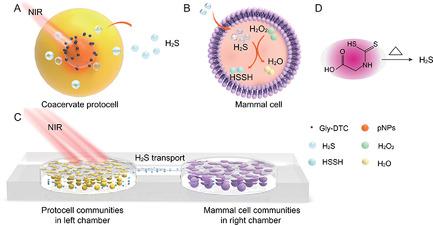当前位置:
X-MOL 学术
›
Advanced Biosystems
›
论文详情
Our official English website, www.x-mol.net, welcomes your
feedback! (Note: you will need to create a separate account there.)
Photothermally Activated Coacervate Model Protocells as Signal Transducers Endow Mammalian Cells with Light Sensitivity
Advanced Biosystems Pub Date : 2021-06-23 , DOI: 10.1002/adbi.202100695 Yu Yao 1 , Yanwen Zhang 1 , Li Li 2 , Yan Huang 1 , Xiaohai Yang 1 , Zhihong Peng 1 , Kemin Wang 1 , Jianbo Liu 1
Advanced Biosystems Pub Date : 2021-06-23 , DOI: 10.1002/adbi.202100695 Yu Yao 1 , Yanwen Zhang 1 , Li Li 2 , Yan Huang 1 , Xiaohai Yang 1 , Zhihong Peng 1 , Kemin Wang 1 , Jianbo Liu 1
Affiliation

|
The development of a novel photothermally activated coacervate model protocell is reported as a signal transducer to endow mammalian cells with light sensitivity. In this system, near-infrared light irradiation triggers H2S release in coacervate model protocells, leading to modulation of the behavior of living cells. The functional coacervate model protocells are prepared by loading metal-alloyed plasmonic nanoparticles and an H2S donor into the liquid coacervate microdroplets. Upon light irradiation, the H2S signal messenger is released through the photothermal effect of plasmonic nanoparticles and photothermal mediated pyrolysis of the H2S donor. The H2S signal is delivered to the mammalian cell community to trigger depletion of reactive oxygen species, reduce the activity of lactate dehydrogenase and improve cell viability. This study provides a new approach to the implementation of chemical signaling in artificial cell colonies and protocell/living cell consortia. The photothermal protocell system offers a powerful platform for light modulation of the behavior of mammalian cells and shows great promise for biomedical applications.
中文翻译:

光热激活凝聚层模型原始细胞作为信号传感器赋予哺乳动物细胞光敏感性
据报道,一种新型光热活化凝聚层模型原始细胞的开发是一种信号传感器,可赋予哺乳动物细胞光敏感性。在该系统中,近红外光照射会触发凝聚层模型原始细胞中H 2 S 的释放,从而调节活细胞的行为。功能凝聚层模型原始细胞是通过将金属合金等离子体纳米粒子和 H 2 S 供体加载到液体凝聚层微滴中来制备的。在光照射下,H 2 S 信号信使通过等离子体纳米粒子的光热效应和 H 2 S 供体的光热介导的热解释放。H 2S 信号被传递到哺乳动物细胞群落,以触发活性氧的消耗,降低乳酸脱氢酶的活性并提高细胞活力。这项研究为在人工细胞集落和原始细胞/活细胞聚生体中实施化学信号提供了一种新方法。光热原始细胞系统为哺乳动物细胞行为的光调制提供了一个强大的平台,并在生物医学应用中显示出巨大的前景。
更新日期:2021-08-07
中文翻译:

光热激活凝聚层模型原始细胞作为信号传感器赋予哺乳动物细胞光敏感性
据报道,一种新型光热活化凝聚层模型原始细胞的开发是一种信号传感器,可赋予哺乳动物细胞光敏感性。在该系统中,近红外光照射会触发凝聚层模型原始细胞中H 2 S 的释放,从而调节活细胞的行为。功能凝聚层模型原始细胞是通过将金属合金等离子体纳米粒子和 H 2 S 供体加载到液体凝聚层微滴中来制备的。在光照射下,H 2 S 信号信使通过等离子体纳米粒子的光热效应和 H 2 S 供体的光热介导的热解释放。H 2S 信号被传递到哺乳动物细胞群落,以触发活性氧的消耗,降低乳酸脱氢酶的活性并提高细胞活力。这项研究为在人工细胞集落和原始细胞/活细胞聚生体中实施化学信号提供了一种新方法。光热原始细胞系统为哺乳动物细胞行为的光调制提供了一个强大的平台,并在生物医学应用中显示出巨大的前景。


















































 京公网安备 11010802027423号
京公网安备 11010802027423号